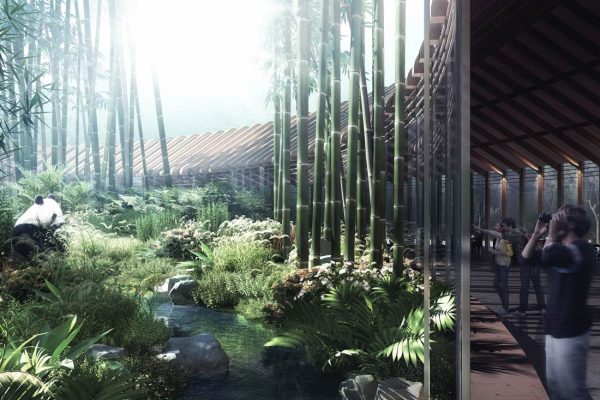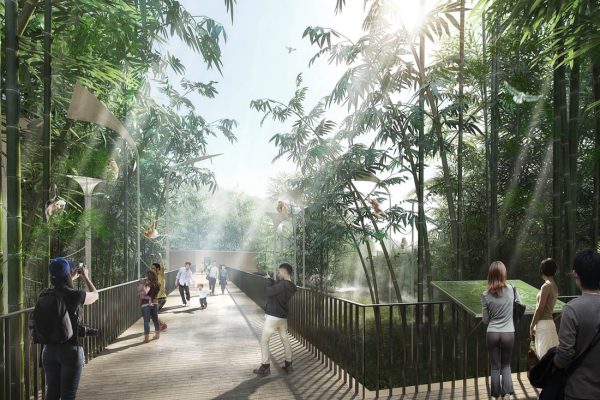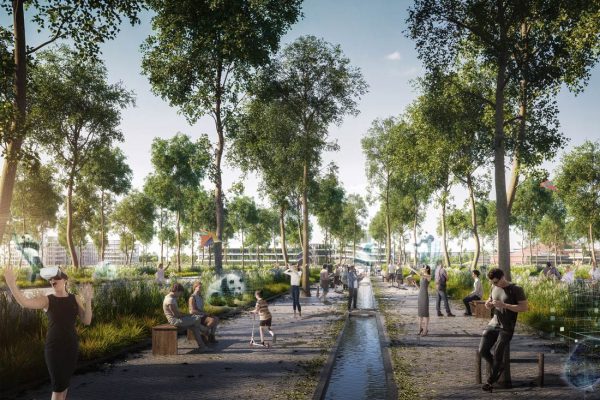HASSELL’s winning masterplan proposal for Panda Land Chengdu aims to dissolve the common idea of humans being dominant over nature.

Chengdu Panda Land Master Plan, China by HASSELL
January 15th, 2019
Home to the giant panda, one of China’s national treasures, the Sichuan Province constitutes the largest contiguous area of panda habitat in the world. The province’s capital city Chengdu has developed its identity and built an international brand around the giant panda. And now it is poised to make a huge investment to protect and further develop its natural asset.
Last year, Chengdu commissioned an international competition for the masterplanning, habitat design and sustainable tourism framework for three sites across the city centred on the conservation, protection and education about the giant panda and Sichuan’s other native flora and fauna.
HASSELL has been named as one of the three winning practices in the competition. The proposal is a collaboration between the HASSELL team helmed by Shanghai-based HASSELL Principal Andrew Wilkinson, Tongji Urban Planning and Design Institute, and habitat design consultant Jon Coe Design.
The three sites are Beihu (35 sq km), Dujiangyan (23 sq km) and Longquan Mountain (11 sq km). HASSELL’s winning design proposes a Panda Trail that connects the three sites and offers a journey highlighted by various experiences based on the surrounding context and target audience.

The Panda Hotel
Beihu offers an opportunity to learn and discover more about the city’s landscape and wildlife via a research centre and cultural innovation centre.
Envisioned for explorers as well as tourists, Dujiangyan offers an immersive experience in a natural park with scenic valleys and an eco-resort.
At Longquan Mountain, a landscape restoration initiative sees the degraded area being revegetated. This live and ongoing process will be on display and serve as a learning venue about the danger and the mitigation of deforestation.

The Monkey Trail
“It’s highly rewarding to be involved in this project that delivers on China’s increasing efforts to protect and increase awareness of this critical species and its native habitat,” said Wilkinson.
A number of design features on the proposal seek to dissolve the common idea that humans are dominant over nature. These include locating the enclosures away from the main paths, limiting visibility to the exhibits through openings, and positioning the animals at a higher level than the visitors.

The Digital Park
Technology will further boost the visitor experience. Visitors eager to experience a close encounter with the giant pandas will be able to do without the expense of the actual animals’ comfort via VR at the trail’s Digital Park.
A searchable and comprehensive guide for specifying leading products and their suppliers
Keep up to date with the latest and greatest from our industry BFF's!

Marylou Cafaro’s first trendjournal sparked a powerful, decades-long movement in joinery designs and finishes which eventually saw Australian design develop its independence and characteristic style. Now, polytec offers all-new insights into the future of Australian design.

Suitable for applications ranging from schools and retail outlets to computer rooms and X-ray suites, Palettone comes in two varieties and a choice of more than fifty colours.

Create a configuration to suit your needs with this curved collection.

Savage Design’s approach to understanding the relationship between design concepts and user experience, particularly with metalwork, transcends traditional boundaries, blending timeless craftsmanship with digital innovation to create enduring elegance in objects, furnishings, and door furniture.

Caring for our mental health is paramount these days and architecture and design can lead the way as Hassell shows in its latest project in Queensland.

MECCA’s Customer Support Centre stays put, but Studio Tate’s interior design has added totally new layers of colour and energy to the space.
The internet never sleeps! Here's the stuff you might have missed

Gray Puksand’s construction-focused facility at TAFE NSW responds to the critical need for a resilient Australian construction industry.

Third in the series of boutique hotels under the Lloyd’s Inn brand, Lloyd’s Inn Kuala Lumpur bring the immediacy of nature to the new high-rise hospitality experience in the heart of a bustling city.

When iconic brands wield their influence, the ripples extend far beyond aesthetics. And so when the MillerKnoll collective formed, the very concept of design shifted, supercharging the industry’s aspiration to create a better world into an unwavering sense of responsibility to do so.